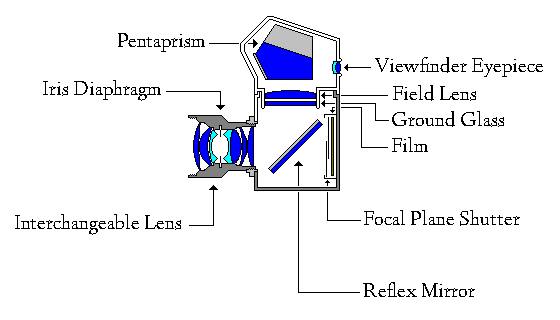
Below is a diagram showing the basic parts of an SLR:

Nearly all 35mm SLR cameras have interchangeable lenses, allowing for the use of wide angle, telephoto, and zoom lenses in addition to the basic standard lens (usually with a 50mm focal length). This makes a major contribution to the versatility of this type of camera.
Usually, because its size depends strongly on the lens design, the iris diaphragm is located within each lens; turning a ring on the lens sets the desired aperture, but the lens is not actually stopped down to that except when the photograph is actually taken. The mechanical coupling that accomplishes this is the only coupling between the lens and the camera body in an SLR using the M42 screw mount.
However, some cameras were different; the Kodak Retina camera had a leaf shutter positioned between the lens and the camera body instead of the usual focal plane shutter. The leaf shutter was, of course, far more common on other types of camera, even if not on SLRs.
The reflex mirror, at an angle of 45 degrees, sends light from the lens up to the ground glass on which the photographer views it, seeing what the photograph to be taken will contain.
This mirror swings up, out of the way, when the focal-plane shutter is about to open and expose the film to take a photograph.
 |
The image above is from Wikimedia Commons, licensed under the Creative Commons Attribution Share-Alike 3.0 Unported License, and is thus available for your use under the same terms. Its author is Hiyotada. |
Canon, in 1965, made a camera, the Canon Pellix, pictured at left, that avoided this motion and noise by instead using a pellicle for the reflex mirror which remained fixed in place, reflecting about a third of the light to the viewfinder, and admitting the other two-thirds to the film. Much later, in 1989, they used this principle again in a short run of the EOS RT model of camera, and a couple of other manufacturers have also tried this principle at least once.
Since I wrote that, I learned that there has been one camera maker that recently made a considerable number of digital cameras of this type. The Alpha 99 camera by SONY, along with related models, such as the Alpha 33, 55, and 77, embodied this principle, and SONY termed these cameras SLT cameras. However, these cameras do not have optical viewfinders; instead, the pellicule divides the light between the camera's main sensor, and a phase-detection system used for the camera's autofocus feature.
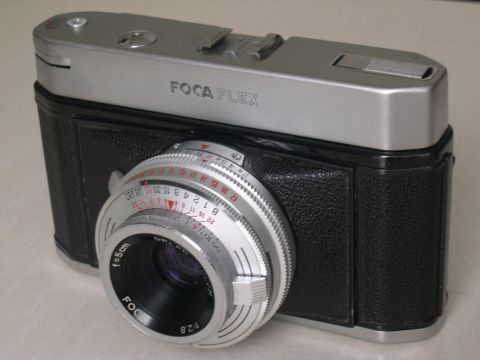 |
The image above is from the Wikimedia Commons, licensed under the Creative Commons Attribution-Share Alike 2.0 France License, and is thus available for your use under the same terms. Its author is Francois Xavier. |
In the film era, a unique camera worth mentioning is the Focaflex, a single-lens reflex camera from France. The original Focaflex I is shown at right; unlike it, the later Focaflex II had interchangeable lenses. It used a pellicle, but it was at the opposite angle to that of the mirror in a normal SLR, and like the mirror in a normal SLR, it still swung out of the way when taking a photograph!
What was going on in that camera? When the pellicle was in position for viewing the image, the image was projected to a screen on the bottom of the camera. That meant that the eyepiece had to be different, since now the image to be seen occupied a smaller angle, and was farther away.
Because light from the scene being photographed passed through the pellicle twice on the way to the photographer's eye, the viewfinder image would not have been as bright in this camera as a conventional camera.
This seemeed to me to be a high price to pay for the benefit of this scheme: the pentaprism could be considerably smaller, and so the Focaflex was slim and compact without a pentaprism bump on the top. However, while this camera would have allowed, at most, a quarter of the incoming light to reach the viewing screen, the Canon Pellix only allowed about a third of the light through to there, and yet that was considered acceptable, so perhaps this was not as bad as I thought.
Above the ground glass is a field lens, which helps to ensure the light from the camera's lens goes to the eye of the photographer.
The pentaprism is shown here with the surfaces that are used to reflect the image on the ground glass plate as being silvered. In the front of the pentaprism is a simple flat surface that will reverse the image once; on the top is a mirror divided into two parts that meet at a right angle in the middle; this kind of mirror does not reverse the image, and so ensures that the pentaprism correctly modifies the image on the ground glass so as to match the orientation of the scene in front of the camera.

A three-dimensional diagram, like this one, taken from a manual for the Praktica fx-2 camera, may be easier to understand than the flat two-dimensional diagram shown above.
Note that a line, composed of dashes and dots, shows the central axis of the path of light from the object being photographed into the camera, and through the viewfinder.
Note that in front of the pentaprism, there is a convex lens appearing to lean against it. What is this extraneous item?
It is there because the Praktica fx-2 is another example of a camera in which the pentaprism is removable. When the pentaprism is not in use, this extra lens may be swung up in order to magnify the central part of the image on the ground glass for finer focusing, as shown in the illustration below, also taken from that camera's manual:
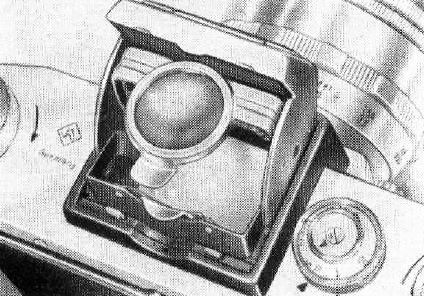
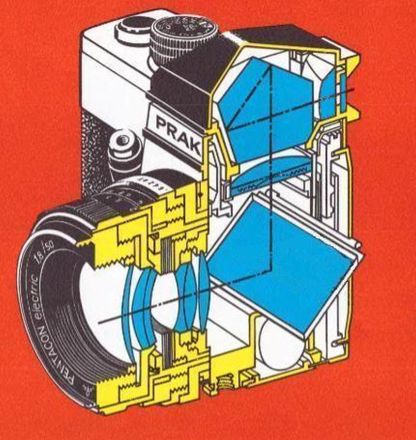
Here is an even clearer three-dimensional diagram, adapted from one that appeared in the manual for the Praktica VLC camera. (I changed it by omitting the camera's automatic exposure system from the diagram, and by highlighting the eyepiece lenses in blue to indicate they also refract the light on its way to the photographer's eye.)
There are possible replacements for the pentaprism in an SLR viewfinder.
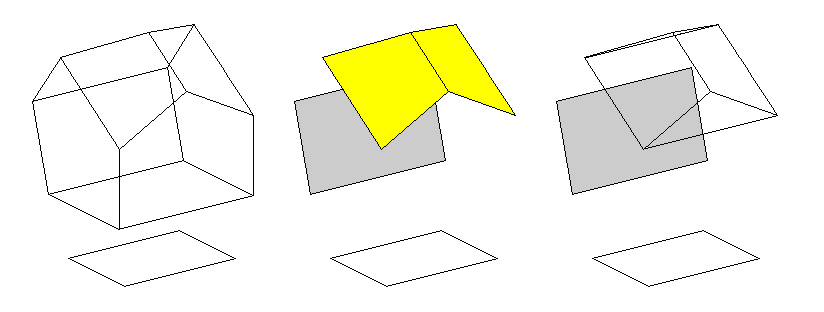
On the left of the diagram above, a pentaprism is shown.
In the middle is shown how one could achieve maximum lightness by eliminating the heavy glass pentaprism, and instead placing mirrors where its reflecting surfaces are. (The fact that distances are affected by the index of refraction of the bulk glass between surfaces is neglected in this diagram.) This is sometimes done for large format cameras, where the pentaprism would be larger and heavier.
On the right is shown an in-between possibility. Here, a much smaller prism is retained for one part of the pentaprism, the two reflecting surfaces at right angles on the roof of the prism, but the other reflecting surface is now provided by a mirror. The prism at the top is known as a Porro prism, giving this type of viewfinder its name.
These three types of viewfinder, as shown, should be nearly equivalent in terms of the size and brightness of the image in the viewfinder; however, I have read that the few cameras which had Porro viewfinders as an option provided smaller and dimmer images in the viewfinder if this type of viewfinder was used; therefore, I must conclude that typical Porro viewfinders actually used, unlike the one in my illustrative diagram above, also made other design changes compared to the pentaprism for the same camera.
I have now found at least part of the answer to that question.
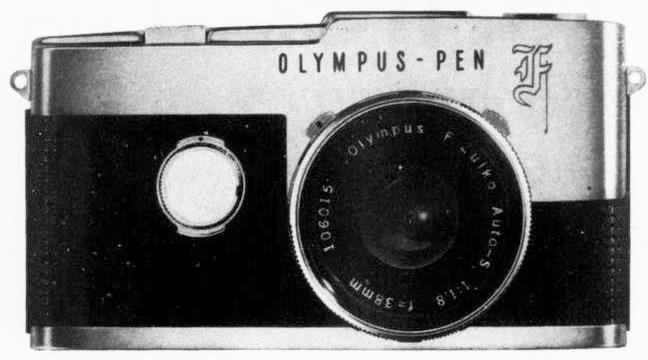
The Olympus Pen-F, advertised with the slogan "no bulge... no bulk", was a single-lens reflex camera, but as you can see from the image, it did not have the large space at the top reserved for a pentaprism.
However, it was also a half-frame camera, taking pictures in the 4:3 aspect ratio, advancing three perforations after each one, so if it had used a conventional pentaprism, that pentaprism would have been smaller. But this camera did use a Porro prism finder instead.
Since it did so to save volume as well as weight, changes to the optical layout beyond the mere use of a Porro prism, as shown above, would have been needed, and so issues of vignetting and image brightness could well have arisen.
But that they could have does not necessarily mean that they did. Herbert Kappler, in the March, 1964 issue of Modern Photography, described the Olympus Pen-F as having a viefinder that was bright and sharp. However, he did note that an earlier pre-production model did have issues in this area, leaving open the possibility that cameras with Porro prism finders from other manufacturers could also do so.
Another type of viewfinder that also uses a Porro prism is the 45 degree finder which is popular with the Hasselblad medium format SLR and other similar medium format SLRs.
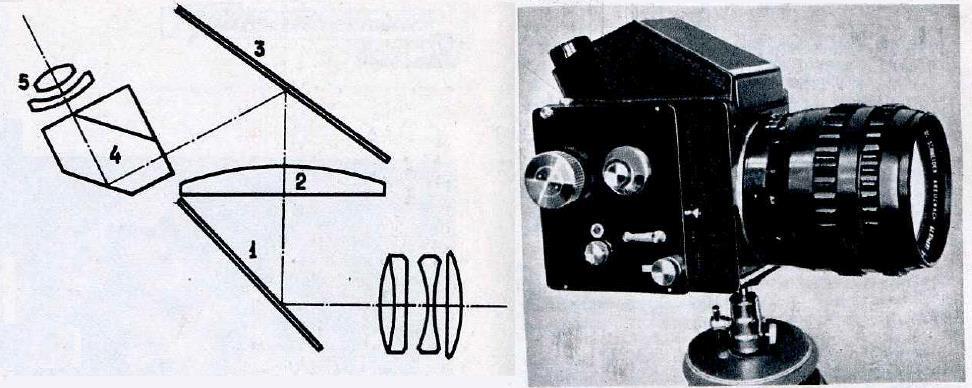
Its principle is illustrated by the diagram above, from a photography magazine from the Soviet Union. (I flipped the diagram, so it would better correspond to the photograph of a camera with such a finder that accompanied it, also included.)
While this is how the angled finder on one imitation of the Hasselblad worked, in the case at least of the PME 45 finder for the Hasselblad itself, the design was completely different.
It used a single piece of glass, more complicated in shape than a pentaprism. The gently sloped portion at the top was the roof portion of the prism, present as in a pentaprism to cause a non-reversing reflection; it was the second reflection that was from an ordinary flat surface in the second leg of the prism that went to the eyepiece (the first leg going to the focusing screen).
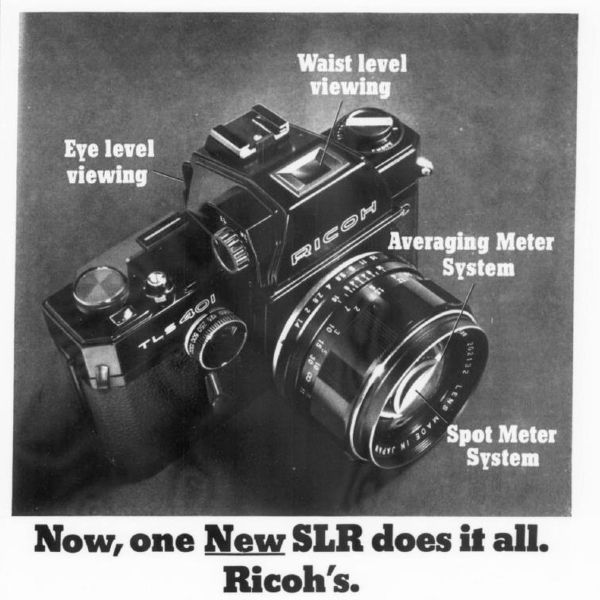
At left is shown a detail from an advertisement for a 35mm camera that used mirrors instead of a pentaprism. It did so in order to take advantage of doing so in a unique way. As indicated on the picture, the camera offered waist-level viewing in addition to eye level viewing; it was possible to look down to see the image on the focusing screen because one or more of the mirrors that replaced the pentaprism could be easily moved out of the way.
As one might guess, the knob on the photographer's right of the pentamirror bump was turned to effect the change.
This camera did, though, have one disadvantage compared to cameras that switched to waist-level viewing by removing a removable pentaprism. Here, one didn't look down at the camera from a distance, instead one had to put one's eye right to the camera to look through a view-finder sized eyepiece lens opening.
Of course, this also had the advantage that one didn't have to worry about losing a removable part, but I doubt that this was a major concern of owners of cameras with removable pentaprisms, both because they so seldom had occasion to switch to waist-level viewing, and because the pentaprism was so important that they were very careful with it.
As well, it is visible from the labels in the photograph in the advertisement that the Ricoh TLS 401 also followed the Mamiya/Sekor 1000 DTL and 500 DTL in offering both spot metering and average metering; so the choice between eye level viewing and waist-level viewing was added to enable this camera to offer the ultimate in flexibility.